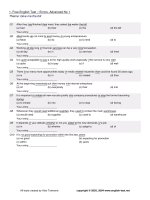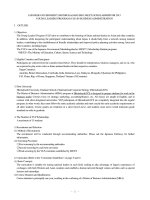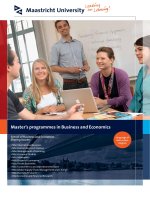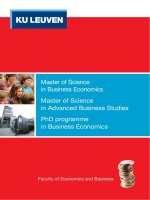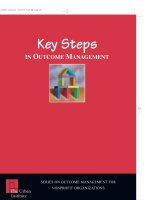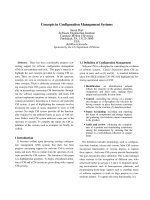FPT advanced diploma in business management 18102011
Bạn đang xem bản rút gọn của tài liệu. Xem và tải ngay bản đầy đủ của tài liệu tại đây (395.51 KB, 59 trang )
Program Specification
University
School
Code
Course Title
Level
Certification
Duration
Language Delivery
FPT University
FPT School of Business (FSB)
FDBM
FPT Advanced Diploma in Business Management
Advanced Diploma (as equivalent of UK HE Level 5)
A transcript is issued upon successful completion of this level by FPT
University
5 months intensive
English
Overall
FPT University is seeking the approval of a bridging program into the Bachelor of Arts in Business
Management Degree from the University of Greenwich. The bridging program has been designed to meet
prequisites for eligible graduates of Vietnamese or foreign colleges into BA degree level studies. On
successful completion of the bridging requirements, students will receive a degree certificate from FPT
and be eligible to enter directly into the third year of BABM program. To enter the bridging program,
eligible graduates must have graduated with a Diploma or Degree from a college/university in Vietnam or
abroad. Students must achieve a minimum GPA of 5.00/10.00 in the bridging course to proceed into third
year of the BABM program.
Program Objectives
The bridging program requires students to study maximum 7 subjects to complete the course. The
proposed curriculum covers the shortfalls in professional studies identified through a matching process of
Performance Academics Results and a formal program gap analysis. There is recognition that the bridging
program developed a high level of business management skills that satisfies the academic requirements
for articulation to the year 3 top-up BABM program. The bridging courses focus on general and
comprehensive knowledge and skills of business management, preparing students to take part in higher
level within BABM program. The bridging program is created for the following purpose:
To assist the students acquire and understand the basic principles of business in order to build a
solid foundation for advanced courses in year 3 top-up BABM.
To strengthen the students’ skills and capacity in business management.
To enable the student attain the minimum requirements for Year 3 BABM.
Approach to Curriculum Matching for FDBM
A development team examined the learning outcomes of the degree and diploma programs to determine
the gaps and create ways to remediate those gaps. This team was composed of the Associate Dean,
Manager of Research and Development Department, Director of FSB International Bachelor Programs,
1|P age
faculty members & program coordinator. The discussions in comparing the diploma and degree programs
with all courses of University of Greenwich in year 1 and year 2 were made in order to outline the skills
and knowledge that students need to be fulfilled.
After reviewing and analyzing program the gap through Academic Performance of graduates from
Vietnam’s colleges and universities, we have divided different majors into 3 distinct groups as below:
a. Relevant Advanced Diploma level qualifications - no need for a Bridging programme - go
direct to the top-up degree. Of course, this is on the assumption that students reach English
language thresholds if their qualifications are not English language medium of instruction.
b. Lower level - e.g. Diploma - relevant qualifications. Need the Bridging programme to reach
an appropriate academic level for entry to the top-up degree
c. Advanced Diploma level qualifications - in non-Business areas. Need the Bridging
programme to provide the necessary subject knowledge and skills for entry to the top-up
degree.
Group (b) will need to take the following bridging courses:
No.
1
2
3
4
Code
ISM201
SSG101
OPM303
ENTR401
Course title
Management Information Systems
Working in Groups
Value Chain Management
Basics of Business Plan Development
Credit
15
15
15
15
Group (c) are expected to study the seven following courses to bridge this gap:
No.
1
2
3
4
5
6
7
Code
MKT101
ACC101
OBE 101
SSC 101
OPM 303
ENTR 401
SSG101
Course title
Principles of Marketing
Principles of Accounting
Organizational Behavior
Business Communication
Value Chain Management
Basics of Business Plan Development
Working in Groups
Credit
15
15
15
15
15
15
15
Different entry points or programmes of study for different entry qualifications are included in the
Appendix Page 57.
There are 30 contact hours per module. Based on the Academic Performance Results, if one has already
studied any above-mentioned subjects (category they are divided), they are exempted from studying that
one. Gap analysis process was conducted by comparing the program of UOG in year 1 and year 2 with the
learning outcomes of graduates and determined how many subjects they have not studied in order to
categorize them.
2|P age
hoho
It is recommended that the approval of a bridging program through which qualifying graduates of
different colleges can develop the additional skills and knowledge to confidently enter the third year of
top-up BABM program. The pathway is a valuable opportunity for diploma/degree graduates to earn a
BA qualification of Business Management that can enhance their professional future. Bridge applicants
must submit a learning result form. Only those whose results meet above-mentioned requirements are
entitled to enter the third year of BABM program. The bridging program then supplements the students’
theoretical and applied skills so that students understand and integrate the principles of management into
higher education. It further develops their research and other management skills too.
Course specification as follows
3|P age
COURSE DESCRIPTION
Course code
Course title
Number of credits
Degree level
Time allocation
Pre-requisite
Main objectives
Description
Student's task
4|P age
ISM 201
Management of Information System
15
Advanced Diploma
1 course = 10 sessions; 1 session = 3 hours
Total: 30 hours
Nil
On completing this course successfully you will be able to:
Knowledge
Understand the basics of managing business information systems.
Understand and distinguish various types of business information
systems existing in organizations;
Understand the role of information technology in business process
"reengineering", and how it can be used to attain competitive
advantages;
Understand the current technical and managerial issues regarding
personal computer technology;
Understand the current technical and managerial issues regarding
networking and telecommunications technology;
Understand the ethical and security issues relating to the use of
information technology.
Skill
build an enhanced entity-relationship model of an organization’s data
This course addresses issues that arise in dealing with management
information as a business resource. As an introduction to the field of
Management Information Systems (MIS), topics covered deal with computer
technologies, information development, and impact of information systems on
business organization at a variety of levels, from personal information systems
to organization information architectures. The course covers both technical and
managerial aspects of MIS. Major attention is given to the implications of
information systems for achieving competitive advantage.
Attend more than 80% of contact hours in order to be accepted to the final
examination
Actively participate in class activities
Fulfill tasks given by instructor after class
Use their own laptop in class only for learning purpose
Read the textbook in advance
Plagiarism
Copyright
Teaching materials
References
Assessment scheme
Scoring scale
Course schedule
Evaluation
structure
Lecture time
5|P age
Access the course website (www.cms.fpt.edu.vn) for up-to-date
information and material of the course, for online supports from teachers
and other students and for practicing and assessment.
Most academic work is heavily dependant on the findings of ideas off others
(i.e. authors, scholars). Indeed, you are encouraged to research widely and
develop research skills. However, you must say where ideas, information,
arguments, diagrams or other theoretical models come from, regardless of
whether you are quoting directly, paraphrasing or simply mentioning or using
data from that source. To do otherwise amounts to plagiarism and is a serious
academic offence.
Plagiarism goes further than the failure to acknowledge quotations,
paraphrases or information from published sources – it also includes copying
or using other students work and downloading material from the internet and
passing it off as your own.
Any cases of plagiarism, cheating or copying, will result in a zero mark for the
piece off assessment, failure of the whole unit orr exclusion from the course.
Copyright is different from plagiarism. Plagiarism is the use of another
person’s work and passing it off as your own, with acknowledgement of the
author. Copyright is the restriction which defines fair use of another’s work.
As a student, you will make use of other people’s copyright material during the
course of your study. You have the right to copy and communicate electronic,
audiovisual and hardcopy material, but limitations do apply, such as only
copying one chapter or 10% of a book or journal article.
Laudon & Laudon (2010), Management Information Systems 11e, Pearson
International Global Edition.
Turban et al (2008), Information Technology for Management – Transforming
Organizations in the Digital Economy 6e, John Wiley & Sons.
J. A. Hoffer, M. B. Prescott, and F. R. McFadden (2007), Modern Database
Management 8e, Pearson/Prentice Hall.
Assignments: 40%
Final exam: 60%
Total: 100%
Completion Criteria: Final Result >=5 & Final Exam Score >= 4
10
See Appendix 1
See Appendix 2
See Appendix 3
Appendix 1 - COURSE SCHEDULE
No.
1.
Subjects
The information System
Revolution: Transforming
Business and Management.
The strategic role of
Information System
Business Process and
Enterprise System
Texts
p. 2-35
4.
Computer and Information
Processing
p.108-139
5.
Telecommunication &
Network
Managing Data Resource
2.
3.
6.
Additional Readings
p.37-70
The Information Executives
Truly Need
p.72-p.107
Case: Can Sears
Reinvent Itself?
Case Study: When two
titans merge:
management,
organization and
technology chllenges
at Citigroup.
Six IT Decisions Your IT People Case: Managging
Shouldn't Make
Hardware Assets Pays
off?
p.176-207
7.
The Internet : E-commerce
and electronic business
p.244-285
8.
Redisigning the
organization with
Information System
p.286-323
9.
Managing Knowledge
p. 354-389
10.
Information System
security and control
p. 418-449
The right mind-set for managing
information technology
Saving IT's soul- Humancentered information
management
FINAL EXAM
6|P age
Assignments
Allibaba case
Case study: can low
price retailers survive
on the Internet?
Case study: How a
Vietnamese university
successfully meet the
challenges of the IT
era?
Case study: Flying the
seat of a DSS.
Case Study: Web site
privacy: How much
should we worry?
Appendix 2 - EVALUATION STRUCTURE
Evaluation
Category
Individual
Assignment
Weight
40%
Final exam
60%
Total
100%
7|P age
Duration
60 mins
Type of
questions
Number
of
questions
Scope of
knowledge
and skill of
questions
How?
Note
Case study
analysis
The exercise
will cover
contents
studied in
the previous
sessions
Assignments will be
given at the end of each
class. Since homework
solutions may be
discussed in class, no
late assignments will be
accepted.
Essay
questions
The question
will cover
the lectures,
class
discussions,
activities,
exercises,
and
textbook.
Students are not allowed
to use any
document/information
in any form in exam
room
Exam
room
Appendix 3 – LECTURE TIME
Time
Monday
Tuesday
Wednesday
*Please check the timetable online in case there are alterations
8|P age
Thursday
Friday
COURSE DESCRIPTION
Course code
Course title
Number of credits
Degree level
Time allocation
Pre-requisite
Main objectives
Description
Student's task
Plagiarism
9|P age
SSG101
Working in Groups
15
Advanced Diploma
1 course = 10 sessions; 1 session = 3 hours
Total: 30 hours
Nil
On completing this course successfully you will be able to:
(1) Identify and apply basic group communication concepts in a variety of
contexts.
(2) Demonstrate effective group interaction skills in a variety of contexts.
(3) Identify and apply group communication strategies and skills that facilitate
the achievement of group goals in a variety of contexts.
(4) Identify and demonstrate essential group discussion strategies and skills in
a variety of contexts.
(5) Explain and apply the principles and practices of ethical communication in
a variety of group contexts.
This course will cover both classic and current theories of group
communication that focus on "how groups work" and include practical
information on group communication strategies and skills that emphasize "how
to work in groups".
Topics included: group development, group membership, group diversity,
group leadership, group motivation, conflict and cohesion in groups, planning
and conducting meetings and making presentations in groups. Learning in the
class will be facilitated through the use of vehicles such as textbook readings,
class discussion, exercises/in-class activities, cases and lectures.
Students are expected to attend class and actively participate in class
discussions and activities. The final grade will be lowered one full letter grade
after three unexcused absences. Two late arrivals to class or early departures
are equivalent to one absence. Attendance on group assignment days is
mandatory. If students are absent, their group will complete the assignment
without them and students will receive an F for the assignment.
Most academic work is heavily dependant on the findings of ideas off others
(i.e. authors, scholars). Indeed, you are encouraged to research widely and
develop research skills. However, you must say where ideas, information,
arguments, diagrams or other theoretical models come from, regardless of
whether you are quoting directly, paraphrasing or simply mentioning or using
data from that source. To do otherwise amounts to plagiarism and is a serious
academic offence.
Plagiarism goes further than the failure to acknowledge quotations,
Copyright
Teaching and
learning materials
Reference
Assessment scheme
Scoring scale
Course schedule
Evaluation
structure
Lecture time
10 | P a g e
paraphrases or information from published sources – it also includes copying
or using other students work and downloading material from the internet and
passing it off as your own.
Any cases of plagiarism, cheating or copying, will result in a zero mark for the
piece off assessment, failure of the whole unit orr exclusion from the course.
Copyright is different from plagiarism. Plagiarism is the use of another
person’s work and passing it off as your own, with acknowledgement of the
author. Copyright is the restriction which defines fair use of another’s work.
As a student, you will make use of other people’s copyright material during the
course of your study. You have the right to copy and communicate electronic,
audiovisual and hardcopy material, but limitations do apply, such as only
copying one chapter or 10% of a book orr journal article.
Isa N.Engleberg and Dianna R.Wynn (2010), Working in Groups:
Communication Principles and Strategies 5e, Boston, MA: Pearson/Allyn &
Bacon.
Carl Harshman and Steve Phillips (1996), Team Training: From the Startup to
High Performance. McGr aw-Hill, Inc
1. In-class Group Activities:
2. Individual Assignment:
Total: 100%
50%
50%
Completion Criteria: Final Result >=5 & Final Exam Score >=4
10
See Appendix 1
See Appendix 2
See Appendix 3
Appendix 1 - COURSE SCHEDULE
Session
1.
Content
Activity: How big is small?
Activity: Case study: benched
Activity: The essential group elements
Activity: It was the best of groups, it was the
worst of groups
Activity: Pieces of a puzzle + discussion
questions
Case study: The study group dilemma
Chapter 2. Group Development
Group development stages
Group goals
Group norms
Characteristics of effective groups
Activities and Discussion Questions 2
Forming Groups
Activity: New kids on the block
Activity: Goal setting with Locke and Latham
Activity: How good is your goal?
Activity: Meeting group member needs
Activity: Group expectation
Activity: Classroom norms
11 | P a g e
Student Homework's
Material
Textbook,
Instructor's
Manual,
PowerPoint
Lectures
Textbook, Case study question
(Page 3, textbook), Group
work (page 25, textbook),
Homework - Essential group
elements (page 26, textbook)
Textbook,
Instructor's
Manual,
PowerPoint
Lectures
Textbook, Case study question
(Page 31, textbook), Group
work (page 48, textbook),
Group assignment: How good
is your goal? (page 49,
textbook)
Initial class meeting/Warm-up
Activity: The autograph hunt
Activity: Why are you taking this course?
Activity: Get acquainted statements
Activity: Speak your mind about colleges
Chapter 1. Introduction to Group
Communication
Succeeding in groups
Defining Group Communication
The nature of group communication
Types of groups
Advantages and disadvantages of working
in groups
Balance: The guiding principle of group
work
2.
Teacher's
Material
3.
4.
5.
Case study: Nice to meet you too
Chapter 3. Group Membership
Member needs
Member roles
Member confidence
Member assertiveness
Activities and Discussion Questions 3
Individual Assignment Guidelines
Activity: Functional group role playing
Activity: Group attraction survey
Activity: Sorting the symptoms
Activity: Cognitive restructuring
Activity: Systematic desentization
Activity: How assertive are you?
Chapter 5. Group leadership
What is leadership?
Leadership and Power
Becoming a leader
Activities and Discussion Questions 5
Leadership theories
The 5M model of Leadership
effectiveness
Diversity and leadership
Activities and Discussion Questions 6
Activity: Wanted - A few good leaders
Activity: Natural born leader
Activity: What constitutes effective leadership
Activity: Select a leader
Activity: Extraordinary leaders
Activity: Battle of the sexes
Activity: They drove me crazy
Activity: Are you ready to lead
Case study: dessert isle
Chapter 6. Group motivation
The role of motivation
Member motivation
Group motivation
Assessment
Activities and Discussion Questions 7
Activity: Your guiding motive
12 | P a g e
Textbook,
Instructor's
Manual,
PowerPoint
Lectures
Textbook, Case study question
(Page 53, textbook), Group
work (page 73, textbook),
Home work - Personal report
of communication (Page 74,
textbook)
Textbook,
Instructor's
Manual,
PowerPoint
Lectures
Textbook, Case study question
(Page 109, 132, textbook)
Textbook,
Instructor's
Manual,
PowerPoint
Lectures
Textbook, Case study (page
139, textbook), Group Work
(page 159, textbook),
Homework (page 160,
textbook)
6.
7.
Activity: It really was the best of teams
Activity: Time out to celebrate!;
Activity: Candygram
Activity: Group motivation inventory
Activity: The engagement index
Chapter 8. Listening in groups
The Challenge of Listening in Groups
Types of Listening
Group Roles and Listening
Improving Listening
Special Listening Challenge
Activity: Listening triads
Activity: Student listening inventory
Activity: Listening excuses, excuses, excuses
Activity: Listening to learn
Chapter 9. Conflict and cohesion in groups
Conflict in groups
Constructive and destructive conflict
Conflict styles
Conflict management strategies
Conflict and member diversity
Group cohesion
Activities and Discussion Questions 8
Activity: Win as much as you can
Activity: Meet the mediator (case studies:
noisy neighbor)
Activity: I wish I'd
Activity: They never ask for directions
Activity: Please do not say that
Activity: What is in a name?
Activity: You too?
Case study: Sociology in trouble
8.
13 | P a g e
Film Watching Analysis Paper or other
optional individual assignment activity by
teachers
Chapter 10. Structured and Creative
Problem Solving in Groups
Group Decision Making
Structured Problem Solving
Creative Problem Solving
Textbook,
Instructor's
Manual,
PowerPoint
Lectures
Textbook, Case study (page
188, textbook), Group Work
(page 206), Homework (page
207, textbook)
Textbook,
Instructor's
Manual,
PowerPoint
Lecture
Textbook, Case study (page
213, textbook), Group Work
(page 230, textbook),
Homework (page 231,
textbook)
Textbook,
Instructor's
Manual,
PowerPoint
Lecture
Textbook, Case study (page
237, textbook), Group Work
(page 263, textbook),
Homework (page 265,
textbook)
9.
Problem-Solving Realities
Activity: Lost on the Moon
Activity: So that’s what it means!
Activity: One step at a time
Activity: Objects of the table
Chapter 12. Planning and conducting
meetings
Meetings
Planning and chairing meetings
Adapting to member behavior
Preparing the minute
Evaluating the meeting
Activities and Discussion Questions 9
Activity: Disrupting Disruptive Behavior
Activity: We have to stop meeting like this
Activity: Planning meeting
Activity: Creating an agenda
Activity: Designing an agenda form
Activity: Post-meeting reaction form
10.
Textbook, Case study (page
295, textbook), Group Work
(page 310, textbook), Group
Assignment (page 311,
textbook)
Individual Assignment Submission (in class)
Quiz 2: Chapters 5-8
Chapter 13. Making presentations in groups
Presentation in groups
Presentation guidelines: Purpose, audience,
credibility, logistics, content, organization,
performance.
Activities and Discussion Questions 10
Activity: A practice delivery speech
Activity: Common ground
Activity: Choosing presentation aids
Activity: Match the organizational patterns
Activity: Oral presentation rating scale
Group project presentation guidelines
Group presentations
Questions and Answers
Mini oral presentation
FINAL EXAM
14 | P a g e
Textbook,
Instructor's
Manual,
PowerPoint
Lecture
Textbook,
Instructor's
Manual,
PowerPoint
Lecture
Textbook, Case study (page
315, textbook)
Textbook, Homework (page
334, textbook), Group
Assignment (page 335,
textbook)
Appendix 2 - EVALUATION STRUCTURE
Evaluation
Category
Weight
In-class Group
Activities
Individual
Assignment
15 | P a g e
Duration
Type of
questions/
Form of
Evaluation
Number of
questions
Scope of
knowledge
and skill of
questions
How?
Note
50%
1. Case study
discussions
2. Games
3. Roleplaying
4. Group
discussion
5. Miniassignment
6. Reading
materials
before class
10
exercises/gam
es/role
plays/cases/mi
niassignment/the
oretical check
Based on
topics of
studied units
Daily
evaluation
The 10
exercises
will be
conducted
like
competitions
among
groups.
Groups are
divided by
the instructor
to ensure the
equal
diversity of
gender,
ability, age,
etc... During
the course,
students will
rotate in two
different
groups (each
group for a
half of the
course)
50%
1400 - 1500
word reports
Each student
will choose a
working group
from a
company to
write on
working in
groups issues
or challenges
faced by that
group. From
the theories
Based on
topics of
studied units
and students'
interviews
On paper
acquired from
this course,
give your
recommendati
ons to this
group for
solving those
issues or
challenges.
The input for
the assignment
must be based
on direct
interviews
with people
from that
company.
Students have
to provide the
interview
records
(audios or
videos) as
well as names,
addresses and
phone
numbers of the
interviewees
with the
reports.
Total
16 | P a g e
100%
Appendix 3 – LECTURE TIME
Time
8.00 – 11.00
14.00-17.00
Monday
Tuesday
Wednesday
*Please check the timetable online in case there are alterations.
17 | P a g e
Thursday
Friday
COURSE DESCRIPTION
Course code
Course title
Number of credits
Degree level
Time allocation
Pre-requisite
Main objectives
OPM303
Value Chain Management
15
Advanced Diploma
1 course = 10 sessions; 1 session = 3 hours
Total: 30 hours
Nil
On completing this course successfully you will be able to:
Knowledge
gain an appreciation of the importance of operations.
understand how a product or service is designed, produced and
delivered to the customer.
learn basic project management principles.
Skills
Demonstrate understanding of the relationship between supply chain
strategy, business strategy and competitive performance.
Explain and apply concepts in strategic sourcing, supply chain
integration and coordination and alliances.
Use strategic cost management tools, such as cost-benefit analyses,
activity-based management and target costing, in value-chain
analyses.
Make rational capital budgeting, long-term financing and dividend
policy decisions that can help enhance the value of the firm.
Use financial derivatives in managing the underlying risk and hence
mitigating the adverse financial effects on the value of the firm.
Attitudes
Description
Student's task
18 | P a g e
learn to appreciate group dynamics in project work.
Activities along the value chain can affect and enhance the value of the firm.
As the firm expands, these activities and related processes become more crossfunctional as opposed to functional-area specific. This broad-based course
provides students with necessary theories and quantitative techniques in
identifying value-adding activities and solving business problems that are
related to management, accounting and finance.
Attend more than 80% of contact hours in order to be accepted to the final
examination
Actively participate in class activities
Fulfill tasks given by instructor after class
Use their own laptop in class only for learning purpose
Read the textbook in advance
Plagiarism
Copyright
Textbook
Reference
19 | P a g e
Access the course website (www.cms.fpt.edu.vn) for up-to-date
information and material of the course, for online supports from teachers
and other students and for practicing and assessment.
Most academic work is heavily dependant on the findings of ideas off others
(i.e. authors, scholars). Indeed, you are encouraged to research widely and
develop research skills. However, you must say where ideas, information,
arguments, diagrams or other theoretical models come from, regardless of
whether you are quoting directly, paraphrasing or simply mentioning or using
data from that source. To do otherwise amounts to plagiarism and is a serious
academic offence.
Plagiarism goes further than the failure to acknowledge quotations,
paraphrases or information from published sources – it also includes copying
or using other students work and downloading material from the internet and
passing it off as your own.
Any cases of plagiarism, cheating or copying, will result in a zero mark for the
piece off assessment, failure of the whole unit orr exclusion from the course.
Copyright is different from plagiarism. Plagiarism is the use of another
person’s work and passing it off as your own, with acknowledgement of the
author. Copyright is the restriction which defines fair use of another’s work.
As a student, you will make use of other people’s copyright material during the
course of your study. You have the right to copy and communicate electronic,
audiovisual and hardcopy material, but limitations do apply, such as only
copying one chapter or 10% of a book orr journal article.
Chopra &Meindl. Supply Chain Management: Strategy, Planning, and
Operation. Prentice-Hall.
Fisher, Marshall. What is the right supply chain for your products? HBR, Mar
01, 1997
Liker Jeffrey K., Thomas Y. Choi, Building Deep Supplier Relationships,
HBR, Dec 01, 2004
Porter, Michael E. (1998) Competitive Strategy. Free Press.
Simchi-Levi, Kaminsky&Simchi-Levi, Designing and Managing the Supply
Chain. McGraw-Hill.
Hansen, Mowen and Guan. 2009. COST MANAGEMENT: Accounting &
Control.Southwestern.
Shank, J. 2006. CASES IN COST MANAGEMENT: a Strategic Emphasis
Third Edition.South-Western.
Brealey, Myers and Marcus.Fundamentals of Corporate Finance., McGrawHill/Irwin (henceforth, BMM).
Brealey, Myers and Allen. Principles of Corporate Finance. McGrawHill/Irwin (henceforth, BMA).
Bodie, Kane and Marcus. Investments. McGraw-Hill/Irwin (henceforth,
BKM).
Seitz and Ellison. Capital Budgeting and Long-Term Financing Decisions.
Thomson/South-Western (henceforth, SE).
Assessment scheme
Individual Assignment: 40%
Final Integrative Take-home Case: 60%
Total: 100%
Completion Criteria: Final Result >=5 & Final Exam Score >= 4
Scoring scale
Course schedule
Evaluation
structure
Lecture time
10
See Appendix 1
See Appendix 2
20 | P a g e
See Appendix 3
Appendix 1 - COURSE SCHEDULE
Session
Coverage
1.
Topics in Competitive Strategy
- Intro to competitive advantage and the
value chain concept
- Cost and differentiation advantages
2.
Supply Chain Strategy and Competitive
Performance
- Understanding the supply chain and
supply chain performance
- Supply chain drivers and metrics
3.
Global Strategic Sourcing, Networks and
Alliances
- Supply contracts, coordination in the
supply chain
- Strategic alliances, procurement and
outsourcing strategies
4.
HMS Textbook:
Chap1&2: Strategic Cost Management and
Cost Concepts
- Introduce how cost management supports
strategic planning and decision making
- Benefit-cost and variance analysis to
evaluate strategic plans
- Product costs, period costs and expenses
in financial statements
- Prepare schedule of COGM and income
statement
HMS Chap2&3: Product Costing
SystemsCost behavior: variable and fixed
costs
Difference between absorption and
variable costing income statements
Job-order costing
Actual, normal and standard costing
Application of job costing to value
chain
5.
21 | P a g e
Reading &
Assignments
Readings: Porter –
Chapters 1-4
Demonstration
Problems/cases
Readings: Chopra –
Chapters 1-3, HBR:
What is the Right
Supply Chain for Your
Products?
Assignment DB1:
Reflection on HBR
article
Case - TSC Stores:
Supply Chain
Management for
Profitable Growth
Readings: Simchi-Levi
– Chapter 4, Chopra –
Chapter 17, HBR:
Building Deep Supplier
Relationships.
Assignment DB2:
Reflection on HBR
article
Assignment A1: case
1.41
Case: Supply Chain
Outsourcing at DB
Toys
Assignment A2:
Reading &
Assignments
Assignment A3:
Session
Coverage
6.
HMS Chap 4&5: Activity-based Costing and
Cost Drivers Analysis
Different levels of resources and
activities
Traditional vs. activity-based costing
Target costing
Cost of value-added and non-valueadded activities
7.
HMS Chap15: Budgeting and Financial
Assignment A4:
Planning
Strategic cost
Operational budgets
management case
Budgeted financial statements
presentation
Behavioral implications of budgets
8.
Advanced topics in capital budgeting such as
capital rationing, investment timing,
sensitivity analysis, scenario analysis and real
options
Lecture: Selected pages from and class notes
based on BMM and BMA
9.
Comprehensive preparation and evaluation of
project proposals
Lecture: Selected pages from and lecture
notes based on BMM and BMA
10. - Advanced topics in capital structure choice
such as impacts of changing capital structure
on the WACC and project evaluation; and the
WACC, free cash flows and firm valuation
- Comprehensive long-term financing
decisions
Lecture: Selected pages from and lecture
notes based on BMM, BMA and BKM
FINAL EXAM
22 | P a g e
Demonstration
Problems/cases
Practice problems
from
BMM and BMA
Selected cases from
SE or KRT
- Practice problems
from BMM, BMA
and BKM
- Selected cases
from SE or KRT
Appendix 2 - EVALUATION STRUCTURE
Evaluation
Category
Individual
Assignment
Weight
40%
Final
Integrative
Take-home
Case
60%
Total
100%
23 | P a g e
Duration
Type of
questions
Number
of
questions
Scope of
knowledge
and skill of
questions
How?
Individual-based
assignments will be
given throughout the
course. You can
discuss the
assignment with your
team members or
classmates, but you
must work on and
turn in your own
solutions.
15 mins
Take-home
Note
Essay
questions
A
comprehensi
ve takehome case
covering all
three basic
functions
(strategy,
accounting
and finance)
Takehome
will be assigned
during the final exam
week
Appendix 3 – LECTURE TIME
Time
Monday
Tuesday
Wednesday
*Please check the timetable online in case there are alterations.
24 | P a g e
Thursday
Friday
COURSE DESCRIPTION
Course code
Course title
Number of credits
Degree level
Time allocation
Pre-requisite
Main objectives
MKT101
Introduction to Marketing
15
Advanced Diploma
1 course = 10 sessions; 1 session = 3 hours
Total: 30 hours
Nil
On completing this course successfully you will be able to:
Knowledge
Demonstrate an understanding of the basic elements of marketing,
including customer needs, marketing strategy, and the marketing
mix.
Demonstrate an understanding of the links between marketing
strategy, activities, customers, and long-term profitability of firms.
Skills
Demonstrate ability to apply marketing concepts to real-world
situations.
Exhibit analytical, research, and presentation skills
Be able to select appropriate methods and tools for implementing
marketing strategies
Description
Student's task
25 | P a g e
Attitudes
Appreciate the marketing situations that can occur for a range of products,
services and ideas, and the marketing practices of various organizations in the
public and private sectors.
The course is designed to provide students with a strong foundation in
marketing based on five key activities:
identifying customer needs
providing customers with the right products or service to meet their needs
assuring availability to customers through the right distribution channels
using promotional activities in ways that motivate purchase as effectively
as possible
setting an appropriate price that maximizes firm profitability while
maintaining customer satisfaction.
Attend more than 80% of contact hours in order to be accepted to the final
examination
Actively participate in class activities
Fulfill tasks given by instructor after class
Use their own laptop in class only for learning purpose
Read the textbook in advance
